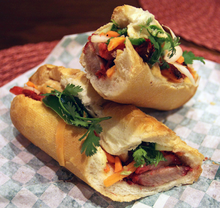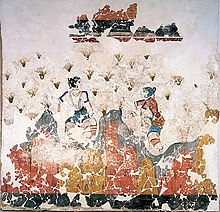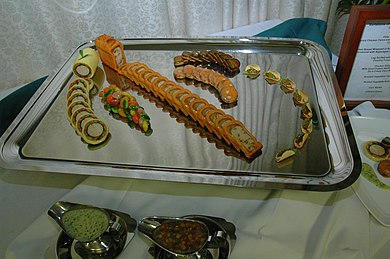
Back بوابة:مطاعم وطعام Arabic প্রবেশদ্বার:খাদ্য Bengali/Bangla دەروازە:خۆراک CKB Portál:Gastronomie Czech Portal:Essen und Trinken German Portalo:Nutrado kaj gastronomio Esperanto Portal:Alimentos Spanish Portaal:Toit Estonian درگاه:خوراک Persian Portail:Alimentation et gastronomie French
F o o d
A portal dedicated to food and foodways
Introduction


Food is any substance consumed by an organism for nutritional support. Food is usually of plant, animal, or fungal origin and contains essential nutrients such as carbohydrates, fats, proteins, vitamins, or minerals. The substance is ingested by an organism and assimilated by the organism's cells to provide energy, maintain life, or stimulate growth. Different species of animals have different feeding behaviours that satisfy the needs of their metabolisms and have evolved to fill a specific ecological niche within specific geographical contexts.
Omnivorous humans are highly adaptable and have adapted to obtain food in many different ecosystems. Humans generally use cooking to prepare food for consumption. The majority of the food energy required is supplied by the industrial food industry, which produces food through intensive agriculture and distributes it through complex food processing and food distribution systems. This system of conventional agriculture relies heavily on fossil fuels, which means that the food and agricultural systems are one of the major contributors to climate change, accounting for as much as 37% of total greenhouse gas emissions. (Full article...)
Cooking, also known as cookery or professionally as the culinary arts, is the art, science and craft of using heat to make food more palatable, digestible, nutritious, or safe. Cooking techniques and ingredients vary widely, from grilling food over an open fire, to using electric stoves, to baking in various types of ovens, reflecting local conditions. Cooking is an aspect of all human societies and a cultural universal.
Preparing food with heat or fire is an activity unique to humans. Archeological evidence of cooking fires from at least 300,000 years ago exists, but some estimate that humans started cooking up to 2 million years ago.
The expansion of agriculture, commerce, trade, and transportation between civilizations in different regions offered cooks many new ingredients. New inventions and technologies, such as the invention of pottery for holding and boiling of water, expanded cooking techniques. Some modern cooks apply advanced scientific techniques to food preparation to further enhance the flavor of the dish served. (Full article...)
Elizabeth David, the British cookery writer, published eight books in the 34 years between 1950 and 1984; the last was issued eight years before her death. After David's death, her literary executor, Jill Norman, supervised the publication of eight more books, drawing on David's unpublished manuscripts and research and on her published writings for books and magazines.
David's first five books, particularly the earlier works, contained recipes interspersed with literary quotation and descriptions of people and places that inspired her. By the time of her third book, Italian Food, David had begun to add sections about the history of the cuisine and the particular dishes that she wrote about. Her interest in the history of cooking led her in her later years to research the history of spices, baking, and ice. (Full article...)
Selected article –
Olive oil is a liquid fat obtained by pressing whole olives, the fruit of Olea europaea, a traditional tree crop of the Mediterranean Basin, and extracting the oil.
It is commonly used in cooking for frying foods or as a salad dressing. It can also be found in some cosmetics, pharmaceuticals, soaps, and fuels for traditional oil lamps. It also has additional uses in some religions. The olive is one of three core food plants in Mediterranean cuisine, together with wheat and grapes. Olive trees have been grown around the Mediterranean since the 8th millennium BC. (Full article...)Selected cuisine -

Soul food is the ethnic cuisine of African Americans. It originated in the American South from the cuisines of enslaved Africans trafficked to the North American colonies through the Atlantic slave trade during the Antebellum period and is closely associated (but not to be confused with) with the cuisine of the American South.
The expression "soul food" originated in the mid-1960s, when "soul" was a common word used to describe African-American culture. Soul food uses cooking techniques and ingredients from West African, Central African, Western European, and Indigenous cuisine of the Americas. Soul food came from the blending of what African Americans ate in their native countries in Africa and what was available to them as slaves. The cuisine had its share of negativity initially. Soul food was initially seen as low class food, and Northern African Americans looked down on their Black Southern counterparts who preferred soul food. The term evolved from being the diet of a slave in the South to being a primary pride in the African-American community in the North such as New York City. (Full article...)Selected ingredient –

Powdered sugar, also called confectioners' sugar and icing sugar is a finely ground sugar produced by milling granulated sugar into a powdered state. It usually contains between 2% and 5% of an anti-caking agent – such as corn starch, potato starch or tricalcium phosphate – to absorb moisture, prevent clumping, and improve flow. Although most often produced in a factory, a proxy for powdered sugar can be made by processing ordinary granulated sugar in a coffee grinder, or by crushing it by hand in a mortar and pestle. (Full article...)
Selected recipe –

In Vietnamese cuisine, bánh mì or banh mi (/ˈbɑːn miː/, /ˈbæn/; Vietnamese: [ɓǎjŋ̟ mì], 'bread') is a short baguette with thin, crisp crust and a soft, airy texture. It is often split lengthwise and filled with meat and savory ingredients like a submarine sandwich and served as a meal, called bánh mì thịt. Plain bánh mì is also eaten as a staple food.
A typical Vietnamese roll or sandwich is a fusion of meats and vegetables from native Vietnamese cuisine such as chả lụa (Vietnamese sausage), coriander (cilantro), cucumber, pickled carrots, and pickled daikon combined with condiments from French cuisine such as pâté, along with red chili and mayonnaise. However, a variety of popular fillings are used, from xá xíu (Chinese barbecued pork) to even ice cream. In Vietnam, bread rolls and sandwiches are typically eaten for breakfast or as a snack. (Full article...)

Human cultivation and use of saffron spans more than 3,500 years and extends across cultures, continents, and civilizations. Saffron, a spice derived from the dried stigmas of the saffron crocus (Crocus sativus), has through history remained among the world's most costly substances. With its bitter taste, hay-like fragrance, and slight metallic notes, the apocarotenoid-rich saffron has been used as a seasoning, fragrance, dye, and medicine.
The wild precursor of domesticated saffron crocus was likely Crocus cartwrightianus, a plant native to mainland Greece, Euboea, Crete, Skyros and some islands of the Cyclades. This species has been used as a wild source of saffron. A study reported in 2019 that the authors considered that a cross between two cytotypes of Crocus cartwrightianus was responsible for the emergence of Crocus sativus. This was probably a unique or very rare event as there is no genetic diversity in commercial saffron today. Another study in 2019 showed that a population of Crocus cartwrightianus near Athens in Attica was the closest match to the theoretical ancestors of Crocus sativus. (Full article...)Selected image –
Selected biography –
B. April 1, 1755, Belley, France – d. February 2, 1826, Paris
"Tell me what you eat, and I will tell you what you are."
Brillat-Savarin
Jean Anthelme Brillat-Savarin (French pronunciation: [ʒɑ̃ ɑ̃tɛlm bʁija savaʁɛ̃], (2 April 1755 – 2 February 1826) was a French lawyer and politician, who, as the author of Physiologie du goût (The Physiology of Taste), became celebrated for his culinary reminiscences and reflections on the craft and science of cookery and the art of eating.
Rising to modest eminence in the last years of France's Ancien Régime, Brillat-Savarin had to escape into exile when the Reign of Terror began in 1793. He spent nearly three years in the United States, teaching French and playing the violin to support himself, before returning to France when it became safe to do so, resuming his career as a lawyer, and rising to the top of the French judiciary. (Full article...)
Did you know (auto-generated) –

- ... that fermented leaves are used to make a meat substitute in Sudan called kawal?
- ... that the island bronze-naped pigeon is a popular food at bars and parties on São Tomé?
- ... that in 1969, the man from Del Monte said yes to Eldorado Electrodata?
- ... that the Cantonese cooking channel Made With Lau began generating about US$50,000 per month in YouTube advertising revenue in under a year?
- ... that Miles Hadfield ensured supplies of food to Coventry during the Second World War Blitz?
- ... that the 2020 documentary film Gather, which explores Native American efforts for food sovereignty and reclamation of ancestral foodways, was named a Critic's Pick by The New York Times?
More did you know –
Related portals
Food topics
The following are topics relating to food
Categories
Food list articles
- See also: Lists of foods and Category:Lists of drinks
The following are some Food list articles on Wikipedia:

- American cheeses
- Appellation d'Origine Contrôlée cheeses
- Apple cultivars
- Bacon dishes
- Bacon substitutes
- Basil cultivars
- Breads
- Breakfast beverages
- Breakfast cereals
- Breakfast foods
- British cheeses
- Cakes
- Candies
- Cheeses
- Cheese soups
- Christmas dishes (list)
- Cocktails
- Cookies
- Dishes using coconut milk
- Diets
- Doughnut varieties
- Egg dishes
- Fermented soy products
- Food additives
- Food additives (Codex Alimentarius)
- Foods named after people
- French cheeses
- French dishes
- Fried dough foods
- Fruits
- List of hamburgers
- Herbs and spices
- Hors d'oeuvre
- Indian dishes
- Indian snack foods
- Indonesian dishes
- Italian dishes
- Japanese snacks
- Japanese dishes
- Jewish dishes
- Kebabs
- Korean beverages
- Mango cultivars
- Moroccan dishes
- Pasta
- Pastries
- Philippine snack food
- Pies, tarts and flans
- Poppy seed pastries and dishes
- Potato dishes
- Puddings
- Raw fish dishes
- Rice dishes
- Rolled foods
- Sauces
- Seafood
- Seeds
- Sandwiches
- Snack foods
- Soft drinks by country
- Soul foods and dishes
- Soups
- Stews
- Street foods
- Tapas
- Turkish dishes
- Twice-baked foods
- Vegetable oils
- Vegetables
- Vodkas
Things you can do
Related WikiProjects
| Parent project: WikiProject Food and Drink | |
| Child projects: | Task forces: (All inactive) |
|
|
| Related projects: | |
New articles
Rules | Match log | Results page (for watching) | Last updated: 2024-06-04 19:24 (UTC)
Note: The list display can now be customized by each user. See List display personalization for details.
- The Captive of the Sahara (edit | talk | history | links | watch | logs | tools) by Lord Cornwallis (talk · contribs · new pages (47)) started on 2024-06-04, score: 10
- Apple bread (edit | talk | history | links | watch | logs | tools) by Heeheemalu (talk · contribs · new pages (9)) started on 2024-06-04, score: 20
- Chiang Yu-An (edit | talk | history | links | watch | logs | tools) by BemrXDD (talk · contribs · new pages (3)) started on 2024-06-03, score: 10
- John Greene (Nurse) (edit | talk | history | links | watch | logs | tools) by Sue8183 (talk · contribs · new pages (1)) started on 2024-06-03, score: 40
- Red Boat (edit | talk | history | links | watch | logs | tools) by Valereee (talk · contribs · new pages (2)) started on 2024-06-02, score: 10
- Agrosuper (edit | talk | history | links | watch | logs | tools) by FrederickEvans (talk · contribs · new pages (27)) started on 2024-06-02, score: 30
- Fowler Ltd. (edit | talk | history | links | watch | logs | tools) by EssNS (talk · contribs · new pages (26)) started on 2024-06-01, score: 10
- Nilla Wafers (edit | talk | history | links | watch | logs | tools) by Voorts (talk · contribs · new pages (46)) started on 2024-05-26, score: 10
- Solari's (edit | talk | history | links | watch | logs | tools) by Nolabob (talk · contribs · new pages (1)) started on 2024-06-01, score: 20
- Nasi katok (edit | talk | history | links | watch | logs | tools) by The Bangsawan (talk · contribs · new pages (13)) started on 2024-06-01, score: 20
- Justin Sterner (edit | talk | history | links | watch | logs | tools) by Muboshgu (talk · contribs · new pages (14)) started on 2024-05-31, score: 10
- Warankasi (edit | talk | history | links | watch | logs | tools) by Wiisstlo (talk · contribs · new pages (5)) started on 2024-05-26, score: 20
- Brennans Bread (edit | talk | history | links | watch | logs | tools) by Gatepainter (talk · contribs · new pages (3)) started on 2024-05-31, score: 20
- Karin-Lis Svarre (edit | talk | history | links | watch | logs | tools) by Ipigott (talk · contribs · new pages (10)) started on 2024-05-31, score: 10
- Indori poha (edit | talk | history | links | watch | logs | tools) by Apocheir (talk · contribs · new pages (5)) started on 2024-05-30, score: 20
- Tanuki (restaurant) (edit | talk | history | links | watch | logs | tools) by Another Believer (talk · contribs · new pages (105)) started on 2024-05-30, score: 10
- Lena Ice Cream (edit | talk | history | links | watch | logs | tools) by Syazwi Irfan (talk · contribs · new pages (3)) started on 2024-05-23, score: 30
- Ko Myeong-seok (edit | talk | history | links | watch | logs | tools) by Explicit (talk · contribs · new pages (3)) started on 2024-05-30, score: 10
- Savanyúság (edit | talk | history | links | watch | logs | tools) by Konnor Martin (talk · contribs · new pages (1)) started on 2024-05-29, score: 10
- Laal maas (edit | talk | history | links | watch | logs | tools) by SafariScribe (talk · contribs · new pages (151)) started on 2024-05-29, score: 30
- Furrundu (edit | talk | history | links | watch | logs | tools) by BaduFerreira (talk · contribs · new pages (3)) started on 2024-05-29, score: 50
- Hyman's Seafood (edit | talk | history | links | watch | logs | tools) by DMVHistorian (talk · contribs · new pages (5)) started on 2024-05-28, score: 10
- Pickup Coffee (edit | talk | history | links | watch | logs | tools) by Hariboneagle927 (talk · contribs · new pages (21)) started on 2024-05-28, score: 20
- Geoffrey Hawtin (edit | talk | history | links | watch | logs | tools) by Chromista (talk · contribs · new pages (1)) started on 2024-05-28, score: 10
- Palani Panchamirtham (edit | talk | history | links | watch | logs | tools) by Magentic Manifestations (talk · contribs · new pages (14)) started on 2024-05-27, score: 10
- Erismatopterus (edit | talk | history | links | watch | logs | tools) by Kevmin (talk · contribs · new pages (20)) started on 2024-05-27, score: 10
- Saskatoon berry pie (edit | talk | history | links | watch | logs | tools) by Reywas92 (talk · contribs · new pages (2)) started on 2024-05-27, score: 30
- Zus Coffee (edit | talk | history | links | watch | logs | tools) by Hariboneagle927 (talk · contribs · new pages (21)) started on 2024-05-27, score: 20
- Space Cola Wars (edit | talk | history | links | watch | logs | tools) by Artem.G (talk · contribs · new pages (14)) started on 2024-05-27, score: 10
- Conchas de Piedra (edit | talk | history | links | watch | logs | tools) by Another Believer (talk · contribs · new pages (105)) started on 2024-05-27, score: 10
- Torta Balcarce (edit | talk | history | links | watch | logs | tools) by Murmuring Rock (talk · contribs · new pages (4)) started on 2024-05-25, score: 20
- Bilal Yalcinkaya (edit | talk | history | links | watch | logs | tools) by Das osmnezz (talk · contribs · new pages (35)) started on 2024-05-23, score: 10
- Andok's (edit | talk | history | links | watch | logs | tools) by Karich28 (talk · contribs · new pages (4)) started on 2024-05-22, score: 20
- Doe Donuts (edit | talk | history | links | watch | logs | tools) by Another Believer (talk · contribs · new pages (105)) started on 2024-05-23, score: 10
- I, the Executioner (2024 film) (edit | talk | history | links | watch | logs | tools) by Οἶδα (talk · contribs · new pages (70)) started on 2024-05-21, score: 10
- Virginia Sole-Smith (edit | talk | history | links | watch | logs | tools) by Marquardtika (talk · contribs · new pages (1)) started on 2024-05-22, score: 10
- Lohusa şerbeti (edit | talk | history | links | watch | logs | tools) by Macrakis (talk · contribs · new pages (8)) started on 2024-05-22, score: 30
- I, the Executioner (edit | talk | history | links | watch | logs | tools) by Οἶδα (talk · contribs · new pages (70)) started on 2024-05-21, score: 10
- Paul Parkman (edit | talk | history | links | watch | logs | tools) by Thriley (talk · contribs · new pages (76)) started on 2024-05-21, score: 10
- Two Roosters Ice Cream (edit | talk | history | links | watch | logs | tools) by Johnson524 (talk · contribs · new pages (3)) started on 2024-05-21, score: 10
- There Be Monsters (edit | talk | history | links | watch | logs | tools) by Another Believer (talk · contribs · new pages (105)) started on 2024-05-21, score: 10
- Chinir saaj (edit | talk | history | links | watch | logs | tools) by Moriwen (talk · contribs · new pages (264)) started on 2024-05-21, score: 30
- Doogh (edit | talk | history | links | watch | logs | tools) by MuhammedBenShalom (talk · contribs · new pages (1)) started on 2024-05-21, score: 20
- Sata physic gardens (edit | talk | history | links | watch | logs | tools) by MChew (talk · contribs · new pages (18)) started on 2024-05-21, score: 10
- Khanom Med Khanoon (edit | talk | history | links | watch | logs | tools) by Quantplinus (talk · contribs · new pages (0)) started on 2024-05-18, score: 10
Associated Wikimedia
The following Wikimedia Foundation sister projects provide more on this subject:
-
Commons
Free media repository -
Wikibooks
Free textbooks and manuals -
Wikidata
Free knowledge base -
Wikinews
Free-content news -
Wikiquote
Collection of quotations -
Wikisource
Free-content library -
Wikiversity
Free learning tools -
Wiktionary
Dictionary and thesaurus
Sources
More portals
© MMXXIII Rich X Search. We shall prevail. All rights reserved. Rich X Search













































